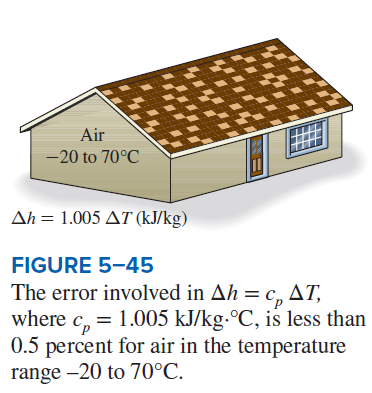The electric heating system of a house is considered. For specified electric power consumption and air flow rate, the air exit temperature is to be determined.
Assumptions 1 This is a steady-flow process since there is no change with time at any point and thus \Delta m_{CV} = 0 and \Delta E_{CV} = 0. 2 Air is an ideal gas since it is at a high temperature and low pressure relative to its critical-point values. 3 The kinetic and potential energy changes are negligible, Δke ≌ Δpe ≌ 0. 4 Constant specific heats at room temperature can be used for air.
Analysis We take the heating section portion of the duct as the system (Fig. 5–44). This is a control volume since mass crosses the system boundary during the process. We observe that there is only one inlet and one exit and thus \dot{m}_{1} = \dot{m}_{2}= \dot{m} . Also, heat is lost from the system and electrical work is supplied to the system.
At temperatures encountered in heating and air conditioning applications, Δh can be replaced by c_{p} \Delta T where c_{p} = 1.005 kJ/kg·°C—the value at room temperature— with negligible error (Fig. 5–45). Then the energy balance for this steady-flow system can be expressed in the rate form as
\begin{aligned}\underbrace{\dot{E}_{\mathrm{in}}-\dot{E}_{\mathrm{out}}}_{\begin{array}{c}\text {Rate of net energy transfer } \\\text { by heat, work, and mass }\end{array}} &=\underbrace{d E_{\mathrm{system}}/dt^{\nearrow{0 (steady)}}}_{\begin{array}{r}\text {Rate of change in internal, kinetic, } \\\text { potential, etc., energies }\end{array}}= 0 \\\dot{E}_{\mathrm{in}}&= \dot{E}_{\mathrm{out}}\\\dot{W}_{e, \text { in }}+\dot{m} h_{1}&=\dot{Q}_{\text {out }}+\dot{m} h_{2} \quad \text { (since } \Delta \mathrm{ke} \cong \Delta \mathrm{pe} \cong 0) \\\dot{W}_{e, \text { in }}-\dot{Q}_{\text {out }}&=\dot{m} c_{p}(T_{2}-T_{1})\end{aligned}
From the ideal-gas relation, the specific volume of air at the inlet of the duct is
v_{1}=\frac{R T_{1}}{P_{1}}=\frac{\left(0.287 \mathrm{kPa} \cdot \mathrm{m}^{3} / \mathrm{kg} \cdot \mathrm{K}\right)(290 \mathrm{~K})}{100 \mathrm{kPa}}=0.832 \mathrm{~m}^{3} / \mathrm{kg}
The mass flow rate of the air through the duct is determined from
\dot{m}=\frac{\dot{V}_{1}}{v_{1}}=\frac{150 \mathrm{~m}^{3} / \mathrm{min}}{0.832 \mathrm{~m}^{3} / \mathrm{kg}}\left(\frac{1 \mathrm{~min}}{60 \mathrm{~s}}\right)=3.0 \mathrm{~kg} / \mathrm{s}
Substituting the known quantities, the exit temperature of the air is determined to be
\begin{aligned}(15 \mathrm{~kJ} / \mathrm{s})-(0.2 \mathrm{~kJ} / \mathrm{s}) &=(3 \mathrm{~kg} / \mathrm{s})\left(1.005 \mathrm{~kJ} / \mathrm{kg} \cdot{ }^{\circ} \mathrm{C}\right)\left(T_{2}-17\right)^{\circ} \mathrm{C} \\T_{2} &=\mathbf{2} 1.9^{\circ} \mathrm{C}\end{aligned}
Discussion Note that heat loss from the duct reduces the exit temperature of air.

